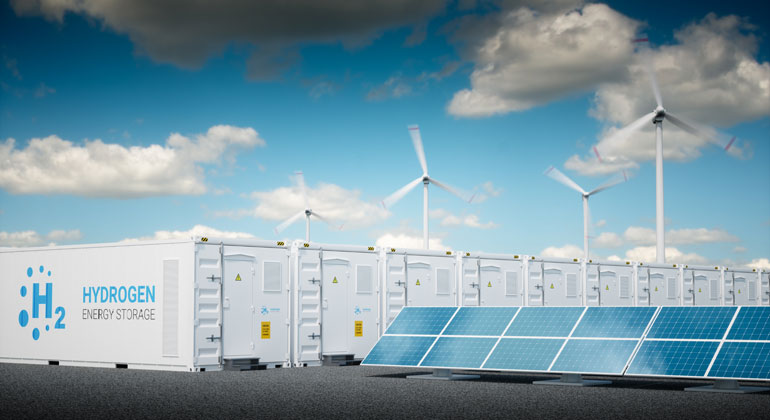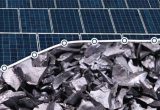H2Insights – New focal topic at WindEnergy Hamburg 2020
The spotlight is on ‘green hydrogen’ production using wind power, a wide range of potential applications, and viable sector-coupling solutions incorporating future-proof business models. WindEnergy Hamburg will take place from 1 – 4 December 2020
A new H2Insights area in Hall B7 brings together various industry segments to form new business ecosystems: wind power equipment vendors, technology developers and wind farm developers, owners and operators along with power-to-gas (hydrogen) conversion specialists for a rapidly expanding international use base.
Many international energy transition initiatives assign a key role to green hydrogen, which is increasingly referred to as ‘tomorrow’s oil, and indispensable for switching from fossil fuel-based towards renewable energy systems.
“This key message is also the headline of Germany’s new National Hydrogen Strategy which was presented on June 16”, says Bernd Aufderheide, President and CEO of Hamburg Messe und Congress. The document highlights the huge possibilities of combining two parallel ambitions for Germany: to become a global hydrogen pioneer, and to open up new high-growth markets. “Hamburg has a special role to play here as the city is strengthening its expertise and promoting the rapid expansion of hydrogen.”
With the eagerly-awaited announcement of the EU Hydrogen Strategy, the European Commission is assigning a key role to green hydrogen in achieving the EU’s climate targets. “More than 60 per cent of final energy consumption can be covered by direct electrification of energy use,” said Giles Dickson, CEO of WindEurope. “However, some sectors, such as energy-intensive industries and heavy-duty transport, will need different solutions. This is where renewable hydrogen, produced through electrolysis using renewable electricity, comes into play. It is an important element of a full energy decarbonisation strategy and will make fossil-based alternatives redundant. The EU Hydrogen Strategy marks the starting point for the rapid development of an innovative European electrolyser industry. WindEnergy Hamburg from 1 to 4 December 2020 offers an ideal platform to help accelerate this development.”
Germany focuses on hydrogen
The German Federal Ministry of Economic Affairs and Energy (BMWi) supports innovative approaches to the development of new hydrogen technologies, including production, efficient transport, storage and many different usages of hydrogen. The focus is on electrolysis, methane pyrolysis, artificial photosynthesis and fuel cells. BMWi has committed to investing €180 million by 2021 to drive innovation, interlinking it closely with Germany’s climate, energy and economic policies. Within the National Hydrogen Strategy framework, BMWi will continue to promote the development of new climate-friendly hydrogen technologies, with over €300 million available until 2023 from the climate fund alone.
Green hydrogen
Hydrogen (H2) can be produced in a number of different conventional, non-renewable processes based on fossil fuels. However, when produced by electrolysis using wind energy it becomes ‘Green H2’ featuring a minimal carbon and ecological footprint. Electrolysis splits water molecules into hydrogen and oxygen molecules using electricity in a proven process known as power-to-gas (PtoG). Many efforts are currently undertaken to optimise the efficiency and output of this technology.
As a highly versatile, multi-purpose energy carrier, H2 is fit for many different applications. This includes the use in fuel cells which directly convert the gas back into electricity as a clean energy source for electric motor(s) in vehicles and other applications. Hydrogen could also be used to temporarily store surplus energy for supply-and-demand balancing in electricity networks with high fluctuation on the input side due to a large share of renewables. Another option is to convert hydrogen and carbon dioxide – which might be taken from post-combustion carbon capture systems – to synthetic methane. Since methane is the main component of natural gas, synthetic methane could be fed into the existing natural gas distribution networks for use in residential heating or industrial processes. Furthermore, synthetic methane produced from green hydrogen could be converted to synthetic liquid fuels such as ‘e-diesel’ in an additional step involving a Fischer-Tropsch reactor. Liquid fuels are easier to store than gaseous fuels and could be instrumental in ongoing efforts towards sustainable shipping and air travel. A wide range of exhibitors will inform WindEnergy Hamburg 2020 visitors about the features and benefits of their specific conversion technologies and solutions.
Networking
At WindEnergy Hamburg, around 80 companies out of a total of 1,400 exhibitors spread over 9 exhibition halls, will offer turnkey energy storage solutions. These exhibitors will all be listed in the ‘Storage Tour’. Hall B7 will be specifically dedicated to hydrogen, featuring a special experts and networking area called H2Insights Area where stakeholders from the hydrogen sector will highlight and discuss their H2 concepts. Two national organisations, Fukushima Prefectural Government (Japan), and Germany’s National Organisation Hydrogen and Fuel Cell Technology (NOW), will likewise be present in this area at the world’s leading wind energy event. For the first time, the American Proton Energy Systems d/b/a Nel Hydrogen US” presents its innovations to the global wind-hydrogen community .
Two specialist companies, H-TEC Systems and Hoeller Electrolyzer, both develop efficient electrolysers and stacks for the production and supply of green hydrogen. Another supplier in this segment is 2G Energy who specialise in the manufacture of combined heat and power plants on the basis of gas engines operating on multiple fuel sources including hydrogen. Major European utilities like RWE Generation and Vattenfall Europe are likewise sharpening their focus on H2, the latter currently developing a comprehensive
hydrogen roadmap 2025.
Other major industrial players such as Siemens AG will also be featured along the Storage Tour, as are leading turbine suppliers whose hydrogen solutions will be exhibited in all nine exhibition halls. Enercon, for instance, is involved in several sector-coupling initiatives, including power-to-gas pilot projects which endeavour to demonstrate that these technologies can be grid-integrated as controllable loads and used effectively for system stabilisation.
Climate first
The green hydrogen-related activities at WindEnergy Hamburg 2020 are a perfect fit for this year’s claim: ‘It is time to put Climate First.’ Hamburg Messe und Congress CEO Bernd Aufderheide believes strongly that green hydrogen is an urgently needed building block for sector coupling and the development of a sustainable, global energy system based on renewables: “Above all, green hydrogen can be produced in regions with abundant wind, solar and hydro-power generating potential. What is especially inspiring is the idea of using offshore wind farms to “green” the fuel supply to the maritime sector. Looking at the programme for our world-leading trade fair for the maritime industry, SMM which will take place in Hamburg in February 2021, we can see new momentum. Green hydrogen can be exported and has the potential to become tomorrow’s climate-friendly crude oil alternative. This provides us with an ideal opportunity to highlight international hydrogen segment exhibitors at H2Insights@WindEnergy Hamburg 2020,” Aufderheide concluded.
‘Power4Climate’ Insights Stage
Green hydrogen will also be an integral part of the agenda at the WindEurope conference held in parallel with WindEnergy in Hamburg, with activities concentrated on the ‘Power4Climate’ Insights Stage. For WindEurope, ‘putting climate first’ means striving to fully decarbonise Europe’s energy systems by 2050. Wind power will play a key role in this process. The ‘Power4Climate’ Insights Stage will explore the energy systems of the future, including the question what must be done today to achieve the set goal by 2050. Experts will discuss challenges such as how fast heating and cooling, transport and industry can be converted to renewable electricity, what type of grids are needed to upgrade today’s power systems so they will meet the required standards, and how the resilience of future grids can be ensured. While resolving these issues, clever and cost-effective energy storage solutions as well as hybrid plants combining wind and photovoltaic power with power-to-gas technology must be developed. All these factors together will be instrumental in building energy systems with sufficient stability and flexibility.
Another question is what business models will drive the transition. In those sectors that cannot be electrified directly, green hydrogen has a special place as part of the energy transition process. WindEurope considers it as one of its main tasks to take an in-depth look at technologies that enable green hydrogen to pave the way towards a cleaner future.








